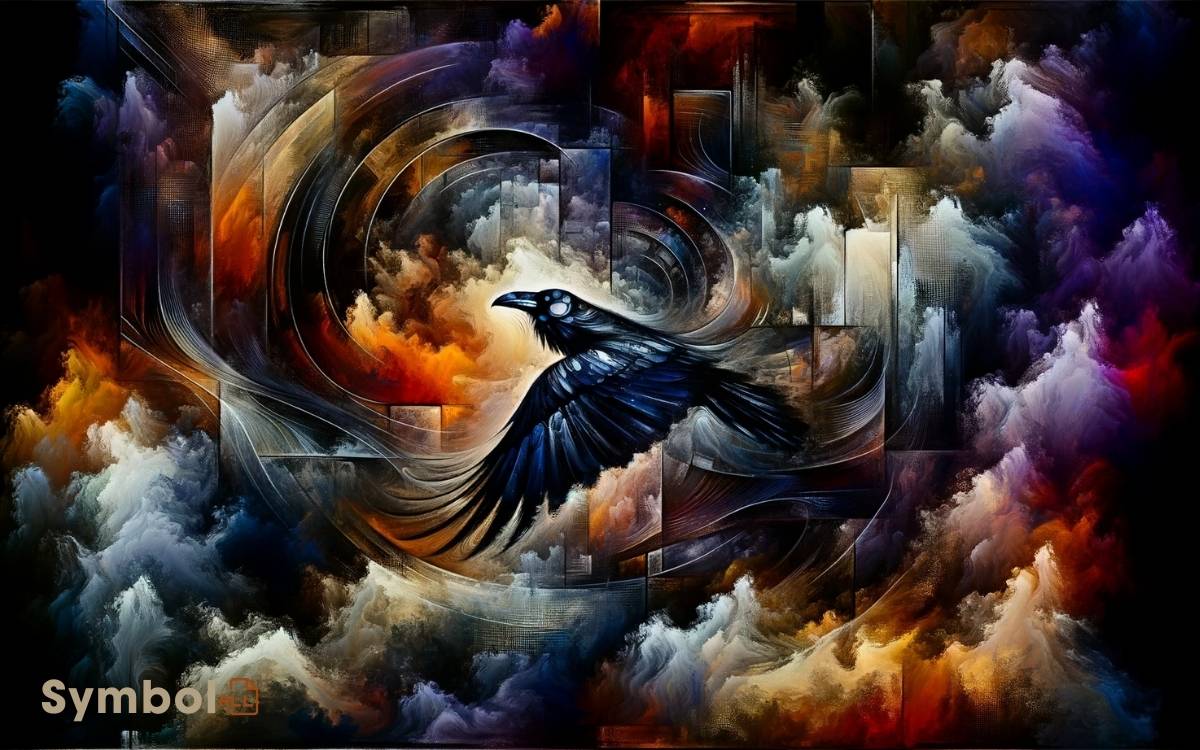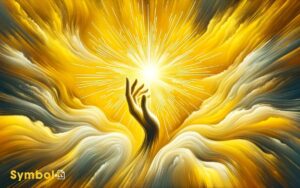What Does the Color of the Raven Symbolize? Cycle Of Life!
The raven’s black plumage immerses you in the heart of mysteries, symbolizing the unknown and the uncharted aspects of life. It embodies the cycle of life and death, tied to the infinity of the night sky.
In various cultures, from Norse lore to Native American beliefs, ravens are revered as guardians of secrets, conduits of divine wisdom, and carriers of souls.
Their exceptional memory positions them as keepers of ancient knowledge, nudging you towards introspection and exploration.
Ravens guide through life’s transformations, signaling renewal and profound change. Their dark hue reveals a world brimming with magic, mystery, and the promise of wisdom yet to be discovered.

Key Takeaways
The Mystery of Black
Throughout history, the raven’s black plumage has symbolized the unknown, weaving a tapestry of mystery and intrigue across various cultures.
You find that this deep, absorbing color doesn’t just represent darkness in a literal sense, but it’s often a metaphor for depth, the unseen, and the unexplored aspects of existence.
In many traditions, black embodies the beginning and the end, encapsulating the cycle of life and death in its void-like hue.
Its association with the night sky and the vastness of space adds layers of meaning, suggesting infinity and the boundless possibilities that lie beyond human comprehension.
This color challenges you to look beyond the surface, inviting introspection and the exploration of the mysteries that lie within and around you.
Ravens in Mythology
You’ll find ravens hold a unique position in Norse lore, often symbolizing wisdom and prophecy.
Across cultures, these birds carry diverse meanings, from omens of death to creators of the world.
This cross-cultural examination reveals the complex symbolism behind the raven’s black hue.
Ravens in Norse Lore
In Norse mythology, ravens hold a significant place, embodying wisdom and serving as pivotal symbols for the gods, especially Odin. These enigmatic birds aren’t just background characters; they’re central to understanding the gods’ connection with the world.
Odin, known as the ‘Raven God,’ is often depicted with two ravens, Huginn and Muninn, representing thought and memory, respectively. These creatures aren’t mere pets; they’re his eyes and ears, traversing the world and bringing back knowledge.
This deep relationship highlights the raven’s role as a bridge between the divine and the mortal, underlining their importance in Norse culture.
The raven’s color, dark as the void, symbolizes the unknown, inviting you to explore the mysteries of the universe, just as the Norse gods did.
Ravens Across Cultures
Ravens have captivated the imaginations of many cultures, each weaving its own tapestry of myths and symbolism around these enigmatic birds. In Native American folklore, they’re seen as creators or tricksters, often shaping the world or teaching valuable lessons.
Contrastingly, Celtic mythology views ravens as omens of war and death, yet also guardians of the underworld, bridging the living with the afterlife. Across the ocean, in Japan, the raven is a divine messenger, embodying the protective qualities and mystical powers of the gods.
Each culture’s interpretation reflects their values, fears, and aspirations, painting a vivid picture of how humans across the globe have found meaning and guidance in the raven’s mysterious allure.
Omens of Death
Exploring the symbolism of the raven’s color is crucial to understanding its role as an omen of death across cultures. Its dark plumage has long been viewed as a foreboding presence, indicating the approach of mortality.
This correlation transforms the raven into mortality’s dark messenger, a universal symbol intertwined into the tapestry of various myths and beliefs.
Mortalitys Dark Messenger
Throughout history, many cultures have regarded ravens as omens of death, attributing to their dark plumage a foreboding message of mortality’s approach.
This perception spans across various traditions, each interpreting the raven’s presence with a unique, yet invariably somber, significance.
- In Norse mythology, the raven is associated with Odin, the god of death and war, serving as his eyes and ears across the world.
- For Native American tribes, ravens are seen as carriers of souls to the afterlife, bridging the mortal world with the spiritual.
- In Celtic lore, they’re believed to hover over battlefields, their presence signaling the impending death of warriors.
These interpretations, rich in cultural heritage, paint the raven not just as a mere bird but as a profound symbol intertwined with humanity’s understanding of life’s fragility and the inevitability of death.
Foreboding Black Presence
In many cultures, the raven’s black plumage stands as a stark symbol of death, casting a shadow of foreboding over those who encounter it.
You’ll find that this dark messenger often carries with it tales of doom and gloom, its presence believed to be an omen of death.
Across the globe, from the Celtic lands where it’s seen as a guide to the afterlife, to the Native American traditions viewing it as a carrier of lost souls, the raven’s shadow touches many myths and legends.
Its black feathers, absorbing all light, mirror the inevitable darkness of death, making you ponder the mysteries beyond this life.
This universal symbol serves as a poignant reminder of life’s fragility and the ever-present nature of mortality.
Guardians of Secrets
Ravens, known as guardians of secrets across various cultures, embody mystery and intelligence in their dark plumage. Their role in folklore and mythology isn’t arbitrary; it’s deeply rooted in their behaviors and characteristics, which have intrigued humans for centuries.
Here are three reasons why ravens are seen as keepers of secrets:
- Exceptional Memory: Ravens have shown remarkable recall abilities, allowing them to remember friends and foes, which aids in their survival and the guarding of territories and secrets.
- Complex Communication: Their varied and sophisticated vocalizations suggest a language that humans have yet to fully decipher, implying they could be exchanging more information than our current comprehension allows.
- Problem-Solving Skills: Their ability to solve complex problems and use tools suggests a level of intelligence that aligns with the guarding of knowledge and secrets.
Messengers of the Gods
As you explore the raven’s symbolism, you’ll discover their role as divine communication channels across various cultures. They’re not just birds; they’re spiritual guidance icons, revered for their ability to convey messages from the gods to humans.
This cross-cultural reverence highlights their unique position in mythology and spiritual practices around the world.
Divine Communication Channels
Throughout history, various cultures have revered ravens as divine messengers, bridging the human and supernatural domains.
Their dark plumage and mysterious presence have made them symbols of:
- The Norse god Odin, who had two ravens, Huginn and Muninn, representing thought and memory. They flew across the world, bringing back news, acting as a conduit for divine wisdom.
- Native American lore, where ravens are seen as creators or transformers, communicating the gods’ will through their actions within creation myths.
- Celtic mythology, interpreting raven sightings as omens or messages from the gods, guiding or warning leaders and warriors.
This cross-cultural reverence underscores a universal belief in ravens as channels of divine communication, transcending mere physical presence to embody deeper, spiritual connections.
Spiritual Guidance Icons
In many cultures, birds like ravens serve as spiritual guidance icons, acting as messengers between the gods and humanity. You’ll find that in Norse mythology, Odin’s ravens, Huginn and Muninn, embody thought and memory, flying across the world to bring back knowledge.
Similarly, Native American traditions often depict ravens as transformers and creators, bridging the gap between the celestial and the terrestrial.
Their dark plumage symbolizes the void from which new ideas and insights emerge, offering a visual metaphor for revelation and understanding.
This cross-cultural reverence highlights a universal human instinct to seek wisdom beyond the tangible. Ravens, with their keen intelligence and mysterious aura, perfectly encapsulate this quest, reminding you that guidance often comes in unexpected forms.
Symbols of Transformation
Ravens, with their dark plumage, symbolize change across various cultures, marking shifts in life, death, and rebirth narratives. Their presence often signals a turning point, urging you to embrace the transformation process.
Here’s what you should consider:
- Life Cycles: In many traditions, ravens are seen as guides through life’s metamorphoses, from birth to death, reflecting the endless cycle of beginning and end.
- Inner Transformation: They encourage introspection and change within oneself, representing the journey toward self-discovery and personal growth.
- Renewal: Ravens are heralds of renewal, symbolizing the cleansing of the old to make way for the new.
Understanding the raven’s symbolism enriches your appreciation of these moments of change, encouraging you to view transformation as an integral part of life’s journey.
The Color of Magic
Exploring the raven’s dark hue, you uncover layers of magic and mystery that span across cultures, offering insights into the mystical associations tied to their color.
This deep, absorbing black isn’t just a shade; it’s a symbol woven into the fabric of various beliefs, representing the unseen and the unknown.
In many traditions, a raven’s color embodies the void from which creation springs, a canvas for the supernatural. It whispers of enchantment and the power to traverse domains, a bridge between the material and the spiritual.
This color invites you to investigate further into the unseen, suggesting that within the shadow lies the potential for profound transformation, not through overt displays, but through the subtle, the nuanced, the intricate dance of forces beyond our ordinary understanding.
Wisdom and Intelligence
You’ll find that across cultures, ravens aren’t just birds of prey but symbols of wisdom and intelligence. Their portrayal in mythology highlights their strategic thinking and problem-solving abilities, often serving as messengers or guides.
Through the lens of symbolic intelligence representations and cognitive skills showcase, we’ll explore how these birds embody knowledge and insight in various traditions.
Ravens in Mythology
Throughout various cultures, ravens are revered as symbols of wisdom and intelligence, embodying traits that have fascinated humans across ages and geographies.
Their presence in mythology highlights their significance:
- Norse Mythology: Ravens hold a special place as Odin’s companions, Huginn (thought) and Muninn (memory), representing the god’s intellectual aspects. They fly across the world, bringing back knowledge.
- Native American Lore: Many tribes consider the raven a trickster, yet also a creator and a guide. This duality emphasizes their intelligent and adaptive nature.
- Celtic Beliefs: In Celtic mythology, ravens are associated with prophecy and insight. Their appearance often heralds change or enlightenment, showcasing their role as messengers of wisdom.
These examples underscore ravens’ universal symbolism as bearers of intelligence and wisdom, transcending mere physical attributes to embody deeper cultural values.
Symbolic Intelligence Representations
Ravens, with their dark plumage and keen sight, serve as powerful symbols of wisdom and intelligence across various cultures, embodying deep insights and profound knowledge.
These enigmatic birds are often hailed as omens of insight, attributed with the ability to traverse between the physical and spiritual domains.
Their presence in folklore and mythology underscores a universal reverence for their intellect. Through stories and legends, ravens are depicted as problem solvers, tricksters, and guides, showcasing their sharp wit and cerebral prowess.
This cross-cultural admiration highlights the raven’s role as a emblem of sagacity, urging you to look beyond the surface and appreciate the depth of understanding these creatures symbolize.
Their black feathers reflect not just the unknown, but the mastery of navigating it with intelligence.
Cognitive Skills Showcase
Demonstrating a remarkable blend of wisdom and intelligence, ravens engage in behaviors that highlight their cognitive prowess across diverse cultures.
Here are three fascinating aspects of their cognitive skills:
- Problem-Solving Abilities: Ravens can solve complex problems, often involving multiple steps and the use of tools. They’re known to work out how to access hard-to-reach food, showcasing their analytical capabilities.
- Social Intelligence: These birds exhibit sophisticated social behaviors, understanding rivalry, cooperation, and even deception among their peers. This indicates a deep comprehension of social dynamics.
- Memory: Ravens possess an impressive memory, capable of remembering individual faces and places over extended periods. This skill aids in their survival, allowing them to navigate and adapt to their environment effectively.
Understanding these aspects gives you a glimpse into the profound intelligence that the color black symbolizes in ravens.
The Duality of Nature
Often, the raven’s black plumage symbolizes the complex duality of nature, embodying both creation and destruction in cultures around the world.
This bird, shrouded in the color of night, serves as a powerful emblem. It navigates the domains of life and death, carrying messages from the gods, foretelling the future, and guiding souls to the afterlife.
In Native American traditions, the raven is a creator, bringing the world into existence, yet in Norse mythology, it whispers news of demise to Odin.
You see, the raven’s dark feathers cloak it in mystery, making it a perfect vessel to explore themes of rebirth and doom. Its presence in various cultures highlights a universal understanding: that life’s beauty is intertwined with its impermanence.
Ravens in Literature
Moving beyond their symbolic significance in nature, ravens have also etched a remarkable presence in literature, where their dark allure unfolds across pages and cultures.
This bird has become a versatile symbol in stories, poems, and myths, often embodying mystery, intelligence, or foreboding.
To understand their literary significance, consider:
- Edgar Allan Poe’s ‘The Raven’ – Here, the raven symbolizes mournful, never-ending remembrance.
- Norse mythology – Ravens are seen as wise creatures, serving as Odin’s eyes and ears.
- Native American stories – Ravens take on the role of a trickster, shaping the world and its creatures.
Each depiction enriches our understanding of ravens, blending their physical attributes with profound symbolic meanings that resonate across different cultures and time periods.
Cultural Interpretations
Throughout history, ravens have consistently emerged in various cultures, each attributing unique symbolic meanings to their enigmatic color and presence.
In Native American lore, they’re seen as creators or tricksters, their dark feathers symbolizing the void from which life springs.
Contrastingly, in Norse mythology, Odin’s ravens, Huginn and Muninn, embody thought and memory, their black plumage representing the deep and sometimes murky depths of the mind.
Meanwhile, in Celtic stories, the raven’s color hints at prophetic abilities, a bridge between life and death, indicating transformation and change.
You’ll find that despite the diversity of interpretations, there’s a common thread: the raven’s blackness often mirrors significant spiritual or existential concepts, ranging from creation and intellect to metamorphosis.
Harbingers of War
Why do ravens, with their dark and ominous presence, frequently emerge as harbingers of war across various cultures? Their symbolism as foretellers of conflict isn’t accidental but deeply rooted in their characteristics and behaviors.
Here’s why:
- Intelligence: Ravens are incredibly smart, capable of strategic thinking. Ancient cultures saw this intelligence as a sign that ravens could foresee or even influence the outcome of battles.
- Scavenging Nature: Their presence on battlefields, feeding on the remains of fallen soldiers, cemented their association with war and its aftermath.
- Mythological Roles: In Norse mythology, Odin’s two ravens, Huginn and Muninn, embody thought and memory. They flew across the world, including battlefields, bringing news of impending conflict to the god.
Their dark plumage mirrors the grim reality of war, making their symbolism as harbingers believable and poignant across different cultures.
The Cycle of Life and Death
Crow’s hue, embodying the smooth shift between life and death, holds deep significance across various cultures, reflecting the eternal cycle that governs all existence.
Its dark plumage, absorbing all light, mirrors the void from which life emerges and to which it inevitably returns.
You’ll find in many traditions, this bird is revered not only as a symbol of mortality but also of rebirth and renewal.
It’s this duality, the interplay between ending and beginning, that makes the crow a powerful emblem. Its presence in myths and folklore often heralds transformation, guiding souls through changes.
Ravens in Native American Beliefs
Delving into Native American beliefs, you’ll discover that ravens are revered as multifaceted symbols, embodying qualities of transformation, creation, and healing across various tribes.
This reverence is deeply rooted in stories that transcend mere folklore, offering insights into the spiritual and practical lives of these communities.
Here’s how ravens stand out:
- Metamorphosis: Ravens are seen as shape-shifters, capable of shifting between the physical and spiritual worlds, guiding souls and delivering messages from the beyond.
- Genesis: Many legends credit ravens with bringing light to the world, showcasing their role as bearers of illumination and creators of life.
- Recovery: Their presence is often interpreted as a sign of upcoming renewal or healing, making them symbols of hope during challenging times.
These aspects highlight the raven’s integral role in the tapestry of Native American cultural and spiritual beliefs.
The Psychological Impact of Black
The color black, often associated with ravens, evokes deep psychological responses across cultures, influencing perceptions of mystery, power, and the unknown.
When you see this dark hue, you’re tapping into centuries of symbolism that transcends geographical boundaries. It’s a color that can make you feel introspective, urging you to look inward and confront your own mysteries and fears.
Black carries a weight of solemnity and authority, often used in fashion and design to convey sophistication and decisiveness. Yet, it’s also a color of mourning and grief in many societies, a universal signal of loss and respect for the departed.
This duality of black – its ability to embody strength and vulnerability – mirrors the complexity of human emotions, making it a profoundly impactful color in your psychological landscape.
Conclusion
In the shadowed whispers of twilight, you find the raven, a silhouette against the fading light, embodying a tapestry of beliefs. Its ebony feathers weave tales of creation and demise, guiding souls and whispering secrets carried on winds across cultures.
You’re touched by its mystery, feeling the weight of ancient omens and divine messages. In its dark gaze, you see reflections of life’s intricate cycle, a reminder of the delicate balance between the seen and unseen, forever bound in its black wings.





